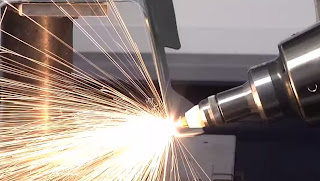Businesses Use Laser Cladding Systems to Improve the Surface Properties of Metals by Applying Performance Coatings
 |
| Laser cladding System |
Laser cladding is a surface modification technique that involves using a laser beam to melt an additional material (usually a functional or wear/corrosion-resistant alloy) and inserting it onto a substrate via the formation of a thin mutual dilution bonding layer. The addition alloy can be introduced into the beam-material interaction zone before (pre-deposited layer) or during processing. For adhesion reasons, only a small layer of the additional material is alloyed to the substrate, and a relatively thick layer of the additional material retains its initial solid qualities. Cobalt-based alloys, nickel-based alloys, iron-based alloys, carbides, and carbide blends are the most common materials used in laser cladding.
A laser cladding system is a welding process that uses laser energy
as a heat source to melt and weld material with different and advantageous
metallurgical properties onto a component with the least amount of chemical
dilution possible. This enables the less expensive substrate's surface
properties to be cost-effectively customized to provide greater resistance to
corrosion, oxidation, wear, and high-temperature fatigue strength. The direct
diode laser cladding system can weld a very thin and smooth single pass metal
layer onto another metal substrate at high deposition rates with little or no
dilution.
This welding method employs customized diode
lasers to achieve the thinnest and purest weld overlay possible. No other
welding process can compete with the quality of diode laser cladding. This
method allows for the modification of the surface metal chemistry of functional
parts without causing significant weld distortion or heat-affected zones. The
advantages of surface modification are corrosion, erosion, or both.
Lasers enable power densities that are not
normally possible with conventional thermal procedures due to their superior
focusing ability. As a result, we are able to process components with minimal
thermal loading and distortion. A laser cladding system is ideal for applications
requiring high dimensional accuracy. Materials that are difficult to weld using
traditional methods, such as high temperature-resistant nickel-based alloys in
gas turbines or tungsten-carbide-filled wear-protection coatings, are also
used. Turbine blades, drilling equipment, and pump components are examples of
common components.
Comments
Post a Comment